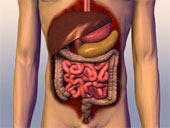
Welcome to the ezine produced by SGI Buddhists that prompts the positive, kindles the constructive, highlights the hopeful and leaves you feeling - well, up!

.jpg)
Most of us probably feel we over-indulged over the recent festive season. So is it time for another fad diet, or a chance to try out the age-old practice of fasting? asks Louise Ellis.
Decades ago, the midwinter feast was a special day of over-eating, a time to celebrate the end of the year by killing the proverbial "fatted goose". For the rest of the year, food supplies were limited, and often scarce. However today, with modern farming methods and food processing, refrigeration and global food distribution, we can literally "feast" every day! And many of us do just that!
Steadily, on a daily basis, the majority of people in the West are overeating, particularly processed food high in fat and sugar. We rarely go through times of scarcity, unless it is through a self-enforced diet, and so we never need to live off our fat reserves.
The result is a rise in figures of obesity. Last month, the NHS Information Centre, published a report, saying that 1 in 4 children are overweight, making them more susceptible to heart disease and cancer in adult life.
Amongst many health experts, there has been a resurgence of interest in the age old practice of fasting, to give the digestive system a chance to rest. In many religions and cultures around the world, fasting is a time-honoured practice, serving as a purification ritual and aid to prayer and meditation. It is defined in Wikipedia as “the act of willingly abstaining from some or all food, drink, or both, for a period of time”. It’s interesting to note that in some faiths, fasting is accompanied by increased prayer and almsgiving.
 Every day we go through a mini fast, from the moment our last meal of the day is digested, through to the first meal the following day, breakfast. Digestion and assimilation of food is an energy intensive process. An important part of the digestive function is the cleaning out and flushing away of toxins and waste products, absorbed from food and the environment, and also from the body’s internal processes. The body has an intricate system for detoxification, through the skin, lungs, liver, kidneys and colon.
Every day we go through a mini fast, from the moment our last meal of the day is digested, through to the first meal the following day, breakfast. Digestion and assimilation of food is an energy intensive process. An important part of the digestive function is the cleaning out and flushing away of toxins and waste products, absorbed from food and the environment, and also from the body’s internal processes. The body has an intricate system for detoxification, through the skin, lungs, liver, kidneys and colon.
However, with such an increase in consumption of processed food, polluted air and water, and stressful lifestyles, our bodies are beginning to struggle to cope with the toxic onslaught, and biologically it is hard for our systems to process and eliminate the amount we are consuming. The result is that waste products become trapped deep in the tissues, causing disease.
As Daniel Reid explains in his book, The Tao of Detox:
‘Many of today’s most common and deadly diseases, such as cancer, diabetes and cirrhosis of the liver, are caused not by viruses or other germs but rather by long-term accumulation of toxins and acid wastes in the body, which create the conditions of tissue toxicity that germs require to infect the body. Similarly, most chronic degenerative conditions, like arthritis, arteriosclerosis, and immune deficiency, are acquired primarily as a result of blood and tissue toxicity produced from things that people put into their own bodies,’ (The Tao of Detox, 2007, Preface)
Reid explains in graphic detail, “Of all the excretory organs, the colon is the most abused and overloaded these days. Believe it or not, the average Western male today carries about 5-6kg of dense, rubbery, mucoid material – a thick toxic sludge – imbedded in his bowels, and none of it is ordinary feces.” (ibid, p. 24)
This is why many health experts are advocating the value of fasting, as it gives the body a chance to deal with the toxic overload. Centres have sprung up around the world offering fasting and detox programmes for a week or more, where the full benefits of supervised fasting can be experienced.
 I decided to try out a week’s juice fast at The LifeCo, near Bodrum in Turkey, which is one of several centres in Europe offering a juice detox programme. I arrived at night from London feeling stressed, and definitely a few pounds overweight, and woke up the following morning to find myself in a beautiful setting, surrounded by date palms with mountains rising behind, and a short walk to the sea. It was so peaceful and relaxing, which are important factors in a successful detox, allowing complete rest of body, mind and spirit.
I decided to try out a week’s juice fast at The LifeCo, near Bodrum in Turkey, which is one of several centres in Europe offering a juice detox programme. I arrived at night from London feeling stressed, and definitely a few pounds overweight, and woke up the following morning to find myself in a beautiful setting, surrounded by date palms with mountains rising behind, and a short walk to the sea. It was so peaceful and relaxing, which are important factors in a successful detox, allowing complete rest of body, mind and spirit.
The LifeCo programme is carefully designed for nutrition, cleansing and removal of toxic matter from the body. Every hour and a half, we were served with a variety of juices, fruit, vegetable, and wheatgrass, plus vitamin and mineral capsules. The juices also contained psyllium, a seed which expands in the intestine, and brushes the colon walls, taking old impacted matter with it; and bentonite, a volcanic clay which draws out toxins from the system.
Massage and daily yoga sessions encourage the lymphatic system to work at optimum to move waste matter from the deeper tissues. And a daily colema (a self-administered turbo charged enema) helps remove waste matter. Removing the toxins and waste products released during the fast is a vital part of a detox, otherwise they will just recirculate back into the system, poisoning it again.
One of the huge advantages of investing time and money in going to a centre to do a detox, is that the whole process is structured, with support and care given to each stage. It’s important to do it in a relaxing space, without the demands of work and daily life, as you can experience a number of so-called detox symptoms, such as lethargy, light headedness, headaches and nausea, caused by the body releasing toxic matter. These are a sure sign that it’s working!
If you are going to do it at home, it is important to research it, to make sure that you are taking all the necessary steps to make it effective, and not create more health problems than are solved. Fiona Robertson, who runs a detox retreat in Biarritz, South West France, has created a Home Detox Box, with everything you need to do a 7-day detox in your own home.
I returned from my week long juice fast in Turkey feeling not just relaxed, but more than that. I definitely felt lighter in my mind, as if I’d released some negative thought patterns, as well as toxins. I didn’t feel such a compulsive need for coffee or chocolate, an effect which has lasted, and an added bonus: I lost seven pounds, which has stayed off.
It was a great kick-start to a new healthy regime, and my plan now is to do a juice fast one day a week, to continue the benefits. This is a manageable approach, and one that has been recommended by many health professionals, as reported by Hugh Wilson in The Independent, and one that could be fitted into a hectic modern lifestyle.

